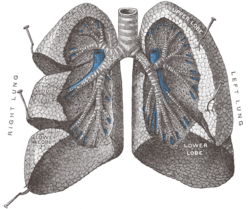| Bronchopulmonary segment | |
|---|---|
 Bronchopulmonary segments visible but not labeled. | |
 | |
| Details | |
| Identifiers | |
| Latin | segmenta bronchopulmonalia |
| TA98 | A06.5.02.001 |
| TA2 | 3280 |
| FMA | 76495 |
| Anatomical terminology | |
A bronchopulmonary segment is a portion of lung supplied by a specific segmental bronchus and its vessels.[1][2] These arteries branch from the pulmonary and bronchial arteries, and run together through the center of the segment. Veins and lymphatic vessels drain along the edges of the segment. The segments are separated from each other by layers of connective tissue that forms them into discrete anatomical and functional units. This separation means that a bronchopulmonary segment can be surgically removed without affecting the function of the others.[3]
There are ten bronchopulmonary segments in the right lung: three in the superior lobe, two in the middle lobe, and five in the inferior lobe. Some of the segments may fuse in the left lung to form usually eight to nine segments (four to five in the upper lobe and four to five in the lower lobe. The delineation of the bronchopulmonary segments was made by Chevalier Jackson and John Franklin Huber at Temple University Hospital.[4]
- ^ Snell, Andrew; Mackay, Jonathan (December 2008). "Bronchoscopic anatomy". Anaesthesia & Intensive Care Medicine. 9 (12): 542–544. doi:10.1016/j.mpaic.2008.09.022. ISSN 1472-0299.
- ^ Foster-carter, A. F.; Hoyle, CLIFFORD (1945-11-01). "The Segments of The Lungs: A Commentary on their Investigation and Morbid Radiology". Diseases of the Chest. 11 (6): 511–564. doi:10.1378/chest.11.6.511. ISSN 0096-0217. PMID 21006145.
- ^ Ugalde, Paula; Camargo, Jose de Jesus; Deslauriers, Jean (November 2007). "Lobes, Fissures, and Bronchopulmonary Segments". Thoracic Surgery Clinics. 17 (4): 587–599. doi:10.1016/j.thorsurg.2006.12.008. ISSN 1547-4127. PMID 18271171.
- ^ Jackson, Chevalier L.; Huber, John Franklin (July 1943). "Correlated Applied Anatomy of the Bronchial Tree and Lungs With a System of Nomenclature". Chest. 9 (4): 319–326. doi:10.1378/chest.9.4.319.